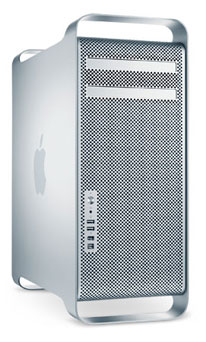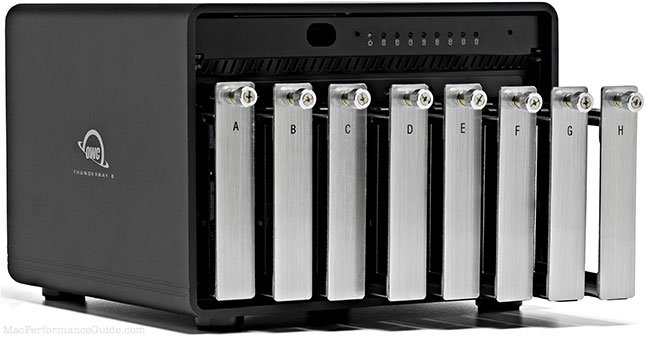
$220 SAVE $130 = 37.0% Western Digital 16.0TB Western Digital Ultrastar DC HC550 3.5-in… in Storage: Hard Drives
|

|

|

|

|

|

|

|

|

|
How to Select and Configure a Mac Pro
Related: CPU cores, hard drive, How-To, Mac Pro, memory, Photoshop
Be sure to read How To Choose a Mac for overall tips and ideas on selecting and buying a Mac.
Mac Pro advantages
My top recommendation for photographers, media professionals and other demanding tasks is the Apple Mac Pro.
There are multiple reasons for this:
- Ergonomics: the Mac Pro is about as quiet as it gets, and all its memory, hard drives, etc are easily accessible without tools. It is aesthetically pleasing also, fitting into even “hip” offices, especially in Redmond.
- Massive, fast storage: The Mac Pro accommodates four internal drives for 12TB of internal storage (4 X 3TB, , all using the built-in SATA connectors.
- Memory expansion: the Mac Pro accepts up to 96GB of memory using 16GB memory modules (48GB for the single-CPU Mac Pro Nehalem).
- CPU cores: Options for 4/6/8/12 CPU cores are available, offering high performance for applications such as video editing and/or running multiple programs simultaneously.
- Apple’s Mac OS X is the best operating system available today, offering state-of-the-art usability and reliability, and avoiding pitfalls like rampant viruses. See (PC or Mac—Making a Sensible Choice).
Recommended configurations PERMALINK
You’re buying a Mac Pro for performance, so dispense with the idea of having 4GB of memory and/or just one hard drive! If that’s sufficient, an iMac can handle the job, albeit with truncated future potential (“dead end Mac”).
When buying from Apple, get the smallest, cheapest hard disk offered, because it will ideally be only a system/applications drive. It’s a throw-away drive, you can buy a fast 3TB drive for under $100. See Setting Up Your Mac for the reasoning on this.
When buying from Apple, get the minimum amount of RAM offered. You can add much more memory at far lower cost on your own.
A higher performance video card isn’t really necessary any more because even the standard one is terrific. Hard-core gamers and video professionals should still look into the fastest possible video card, but most tasks won’t see any difference from the “faster” card.
Best performance and value
Since multiple cores remain underutilized, most users will max-out the real-world benefits with six CPU cores. The best choice for most users desiring speed is the 3.33GH 6-core model (as of September 2011). Video users should consider a 12-core model.
After buying, add memory and drives. Consider refurbished models at 8-15% off. Don’t forget that for demanding tasks, memory and disk speed must be appropriate for the task.
There are scenarios when for the very fastest model make sense: when time is truly money. A photographic studio contacted me for advice on their issue: slow Photoshop opening and saving files. This problem was affecting the studio’s ability to process a large number of image files on a daily basis. Clearly, the fastest dual-CPU system is in order, but my advice was more practical: use a striped RAID and save as uncompressed TIF, good for up to 20X faster performance!
Need to configure a Mac Pro or other Mac for serious use? Consider a consultation.
Adding memory
Adequate memory is the name of the game: you cannot have too much, though you can have too little. Too little can slow things down substantially, making the slowest model perform not too differently from the fastest one. Photoshop users can determine how much is enough by looking at scratch file sizes How.
Anyone using Photoshop or other memory-intensive applications should consider investing immediately in 24GB or 48GB of memory.
Note that more than 24GB makes sense only for specific use-cases — there are no mainstream 64-bit programs that can make use of it (that may change in late 2009). However, Photoshop CS5 users an benefit by keeping files in memory, so that the scratch volume sees little use.
Eight-bay Thunderbolt 3 high-performance storage for photo and video.
Hard drives or SSDs.
Non-RAID or RAID-0/1/4/5/10.
Capacities up to 144 Terabytes!
Adding hard drives
Advanced solutions include SAS and miniSAS and Thunderbolt; these are not covered here. Standard SATA drives offer superb value and performance for the money; other alternatives are much more expensive and/or lower capacity.
Fead Why you need more space than you need and Hard Drive Speed Factors. Larger (1TB) hard drives aren’t just about storage capacity: it’s about performance.
Seagate 22TB IronWolf Pro 7200 rpm SATA III 3.5" Internal NAS HDD (CMR)
SAVE $100

 diglloydTools™
diglloydTools™



